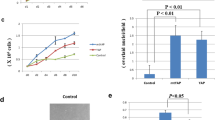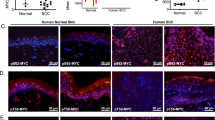Abstract
Activation of the transcription factor AP-1 (activator protein-1) is required for tumor promotion and maintenance of malignant phenotype. A number of AP-1-regulated genes that play a role in tumor progression have been identified. However, AP-1-regulated genes driving tumor induction are yet to be defined. Previous studies have established that expression of a dominant-negative c-Jun (TAM67) inhibits phorbol 12-tetradecanoyl-13-acetate (TPA)-induced AP-1 transactivation as well as transformation in mouse epidermal JB6/P+ cells and tumor promotion in mouse skin carcinogenesis. In this study, we utilized the tumor promotion-sensitive JB6/P+ cells to identify AP-1-regulated TAM67 target genes and to establish causal significance in transformation for one target gene. A 2700 cDNA microarray was queried with RNA from TPA-treated P+ cells with or without TAM67 expression. Under conditions in which TAM expression inhibited TPA-induced transformation, microarray analysis identified a subset of six genes induced by TPA and suppressed by TAM67. One of the identified genes, the high-mobility group protein A1 (Hmga1) is induced by TPA in P+, but not in transformation-resistant P cells. We show that TPA induction of the architectural transcription factor HMGA1 is inhibited by TAM67, is extracellular–signal-regulated kinase (ERK)-activation dependent, and is mediated by AP-1. HMGA1 antisense construct transfected into P+ cells blocked HMGA1 protein expression and inhibited TPA-induced transformation indicating that HMGA1 is required for transformation. HMGA1 is not however sufficient as HMGA1a or HMGA1b overexpression did not confer transformation sensitivity on P− cells. Although HMGA1 expression is ERK dependent, it is not the only ERK-dependent event required for transformation because it does not suffice to rescue ERK-deficient P− cells. Our study shows (a) TAM 67 when it inhibits AP-1 and transformation, targets a relatively small number of genes; (b) HMGA1, a TAM67 target gene, is causally related to transformation and therefore a potentially important target for cancer prevention.
This is a preview of subscription content, access via your institution
Access options
Subscribe to this journal
Receive 50 print issues and online access
$259.00 per year
only $5.18 per issue
Buy this article
- Purchase on Springer Link
- Instant access to full article PDF
Prices may be subject to local taxes which are calculated during checkout








Similar content being viewed by others
References
Abe N, Watanabe T, Sugiyama M, Uchimura H, Chiappetta G, Fusco A and Atomi Y . (1999). Cancer Res., 59, 1169–1174.
Angel P and Karin M . (1991). Biochim. Biophys. Acta, 1072, 129–157.
Angel P, Szabowski A and Schorpp-Kistner M . (2001). Oncogene, 20, 2413–2423.
Balmain A . (2001). Nat. Rev. Cancer, 1, 77–82.
Berlingieri MT, Pierantoni GM, Giancotti V, Santoro M and Fusco A . (2002). Oncogene, 21, 2971–2980.
Bernstein LR, Bravo R and Colburn NH . (1992). Mol. Carcinog., 6, 221–229.
Bernstein LR and Colburn NH . (1989). Science, 244, 566–569.
Bernstein LR, Ferris DK, Colburn NH and Sobel ME . (1994). J. Biol. Chem., 269, 9401–9404.
Bouallaga I, Teissier S, Yaniv M and Thierry F . (2003). Mol. Cell. Biol., 23, 2329–2340.
Brown PH, Alani R, Pries LH, Szabo E and Birrer MJ . (1993). Oncogene, 8, 877–886.
Budunova IV, Perez P, Vaden VR, Spiegelman VS, Slaga TJ and Jorcano JL . (1999). Oncogene, 18, 7423–7431.
Bustin M and Reeves R . (1996). Prog. Nucleic Acid. Res. Mol. Biol., 54, 35–100.
Chang PL, Cao M and Hicks P . (2003). Carcinogenesis, 24, 1749–1758.
Chiappetta G, Bandiera A, Berlingieri MT, Visconti R, Manfioletti G, Battista S, Martinez-Tello FJ, Santoro M, Giancotti V and Fusco A . (1995). Oncogene, 10, 1307–1314.
Chin MT, Pellacani A, Wang H, Lin SS, Jain MK, Perrella MA and Lee ME . (1998). J. Biol. Chem., 273, 9755–9760.
Chinenov Y and Kerppola TK . (2001). Oncogene, 20, 2438–2452.
Cmarik JL, Li Y, Ogram SA, Min H, Reeves R and Colburn NH . (1998). Oncogene, 16, 3387–3396.
Cmarik JL, Min H, Hegamyer G, Zhan S, Kulesz-Martin M, Yoshinaga H, Matsuhashi S and Colburn NH . (1999). Proc. Natl. Acad. Sci. USA, 96, 14037–14042.
Colburn NH, Former BF, Nelson KA and Yuspa SH . (1979). Nature, 281, 589–591.
Colburn NH, Gindhart TD, Hegamyer GA, Blumberg PM, Delclos KB, Magun BE and Lockyer J . (1982). Cancer Res., 42, 3093–3097.
Colburn NH, Wendel EJ and Abruzzo G . (1981). Proc. Natl. Acad. Sci. USA, 78, 6912–6916.
Cooper S, Young MR, Colburn N and Bowden GT . (2003). Mol. Cancer Res., 1, 848–854.
Craig AM, Smith JH and Denhardt DT . (1989). J. Biol. Chem., 264, 9682–9689.
Dhar A, Young MR and Colburn NH . (2002). Mol. Cell. Biochem., 234-235, 185–193.
Dong Z, Birrer MJ, Watts RG, Matrisian LM and Colburn NH . (1994). Proc. Natl. Acad. Sci. USA, 91, 609–613.
Dong Z, Lavrovsky V and Colburn NH . (1995). Carcinogenesis, 16, 749–756.
Du W, Thanos D and Maniatis T . (1993). Cell, 74, 887–898.
Eto I . (1998). Cell Prolif., 31, 71–92.
Friedmann M, Holth LT, Zoghbi HY and Reeves R . (1993). Nucleic Acids Res., 21, 4259–4267.
Frost JA, Geppert TD, Cobb MH and Feramisco JR . (1994). Proc. Natl. Acad. Sci. USA, 91, 3844–3848.
Hanahan D and Weinberg RA . (2000). Cell, 100, 57–70.
Himes SR, Coles LS, Reeves R and Shannon MF . (1996). Immunity, 5, 479–489.
Himes SR, Reeves R, Attema J, Nissen M, Li Y and Shannon MF . (2000). J. Immunol., 164, 3157–3168.
Hsu T-C, Nair R, Tulsian P, Hegamyer G, Young MR and Colburn NH . (2001). Cancer Res., 61, 4160–4168.
Huang C, Ma WY and Dong Z . (1999). Oncogene, 18, 2828–2835.
Huang C, Ma WY, Young MR, Colburn N and Dong Z . (1998). Proc. Natl. Acad. Sci. USA, 95, 156–161.
Jochum W, Passegue E and Wagner EF . (2001). Oncogene, 20, 2401–2412.
Johnston IM, Spence HJ, Winnie JN, McGarry L, Vass JK, Meagher L, Stapleton G and Ozanne BW . (2000). Oncogene, 19, 5348–5358.
Karin M, Liu Z and Zandi E . (1997). Curr. Opin. Cell. Biol., 9, 240–246.
Kovacic P and Jacintho JD . (2001). Curr. Med. Chem., 8, 773–796.
Lewis H, Kaszubska W, DeLamarter JF and Whelan J . (1994). Mol. Cell. Biol., 14, 5701–5709.
Li J-J, Cao Y, Young MR and Colburn NH . (2000). Mol. Carcinogen., 29, 159–169.
Li JJ, Westergaard C, Ghosh P and Colburn NH . (1997). Cancer Res., 57, 3569–3576.
Ogram SA and Reeves R . (1995). J. Biol. Chem., 270, 14235–14242.
Ozanne BW, McGarry L, Spence HJ, Johnston I, Winnie J, Meagher L and Stapleton G . (2000). Eur. J. Cancer, 36, 1640–1648.
Pedulla ML, Treff NR, Resar LM and Reeves R . (2001). Gene, 271, 51–58.
Ram TG, Reeves R and Hosick HL . (1993). Cancer Res., 53, 2655–2660.
Reeves R, Edberg DD and Li Y . (2001). Mol. Cell. Biol., 21, 575–594.
Reeves R and Nissen MS . (1999). Methods Enzymol., 304, 155–188.
Robles AI and Conti CJ . (1995). Carcinogen., 16, 781–786.
Shaulian E and Karin M . (2001). Oncogene, 20, 2390–2400.
Sovak MA, Bellas RE, Kim DW, Zanieski GJ, Rogers AE, Traish AM and Sonenshein GE . (1997). J. Clin. Invest., 100, 2952–2960.
Suzukawa K, Weber TJ and Colburn NH . (2002). Environ. Health Perspect., 110, 865–870.
Tamimi Y, van der Poel HG, Denyn MM, Umbas R, Karthaus HF, Debruyne FM and Schalken JA . (1993). Cancer Res., 53, 5512–5516.
Thanos D and Maniatis T . (1995). Cell, 83, 1091–1100.
van Dam H and Castellazzi M . (2001). Oncogene, 20, 2453–2464.
Watts RG, Ben-Ari ET, Bernstein LR, Birrer MJ, Winterstein D, Wendel E and Colburn NH . (1995). Mol. Carcinogen., 13, 27–36.
Watts RG, Huang C, Young MR, Li JJ, Dong Z, Pennie WD and Colburn NH . (1998). Oncogene, 17, 3493–3498.
Whiteside ST and Israel A . (1997). Semin. Cancer Biol., 8, 75–82.
Wood LJ, Maher JF, Bunton TE and Resar LM . (2000a). Cancer Res., 60, 4256–4261.
Wood LJ, Mukherjee M, Dolde CE, Xu Y, Maher JF, Bunton TE, Williams JB and Resar LM . (2000b). Mol. Cell. Biol., 20, 5490–5502.
Yang CS, Maliakal P and Meng X . (2002). Annu. Rev. Pharmacol. Toxicol., 42, 25–54.
Yang HS, Jansen AP, Komar AA, Zheng X, Merrick WC, Costes S, Lockett SJ, Sonenberg N and Colburn NH . (2003). Mol. Cell. Biol., 23, 26–37.
Yang H-S, Jansen AP, Nair R, Shibara K, Verma AK, Cmarik JL and Colburn NH . (2001). Oncogene, 20, 669–676.
Young MR, Farrell L, Lambert PF, Awasthi P and Colburn NH . (2002a). Mol. Carcinogen., 34, 72–77.
Young MR, Li JJ, Rincon M, Flavell RA, Sathyanarayana BK, Hunziker R and Colburn N . (1999). Proc. Natl. Acad. Sci. USA, 96, 9827–9832.
Young MR, Nair R, Bucheimer N, Tulsian P, Brown N, Chapp C, Hsu TC and Colburn NH . (2002b). Mol. Cell. Biol., 22, 587–598.
Young MR, Yang HS and Colburn NH . (2003). Trends Mol. Med., 9, 36–41.
Acknowledgements
We thank Ms. Jen Adair (Department of Biochemistry, School of Molecular Biosciences, Washington State University) for providing the figure showing specificity of the MR-19 antibody to HMGA1 and not HMGA2. We thank Mrs Annie Rogers (Basic Research Laboratory, National Cancer Institute, Frederick, MD, USA) for help with editing.
Author information
Authors and Affiliations
Corresponding author
Additional information
Supplementary information accompanies the paper on Oncogene website (http://www.nature.com/onc).
Supplementary information
Rights and permissions
About this article
Cite this article
Dhar, A., Hu, J., Reeves, R. et al. Dominant-negative c-Jun (TAM67) target genes: HMGA1 is required for tumor promoter-induced transformation. Oncogene 23, 4466–4476 (2004). https://doi.org/10.1038/sj.onc.1207581
Received:
Revised:
Accepted:
Published:
Issue Date:
DOI: https://doi.org/10.1038/sj.onc.1207581
Keywords
This article is cited by
-
High mobility group A1 (HMGA1) protein and gene expression correlate with ER-negativity and poor outcomes in breast cancer
Breast Cancer Research and Treatment (2020)
-
HMGA1 drives stem cell, inflammatory pathway, and cell cycle progression genes during lymphoid tumorigenesis
BMC Genomics (2011)
-
c-Jun Promotes whereas JunB Inhibits Epidermal Neoplasia
Journal of Investigative Dermatology (2011)
-
Roles of HMGA proteins in cancer
Nature Reviews Cancer (2007)



